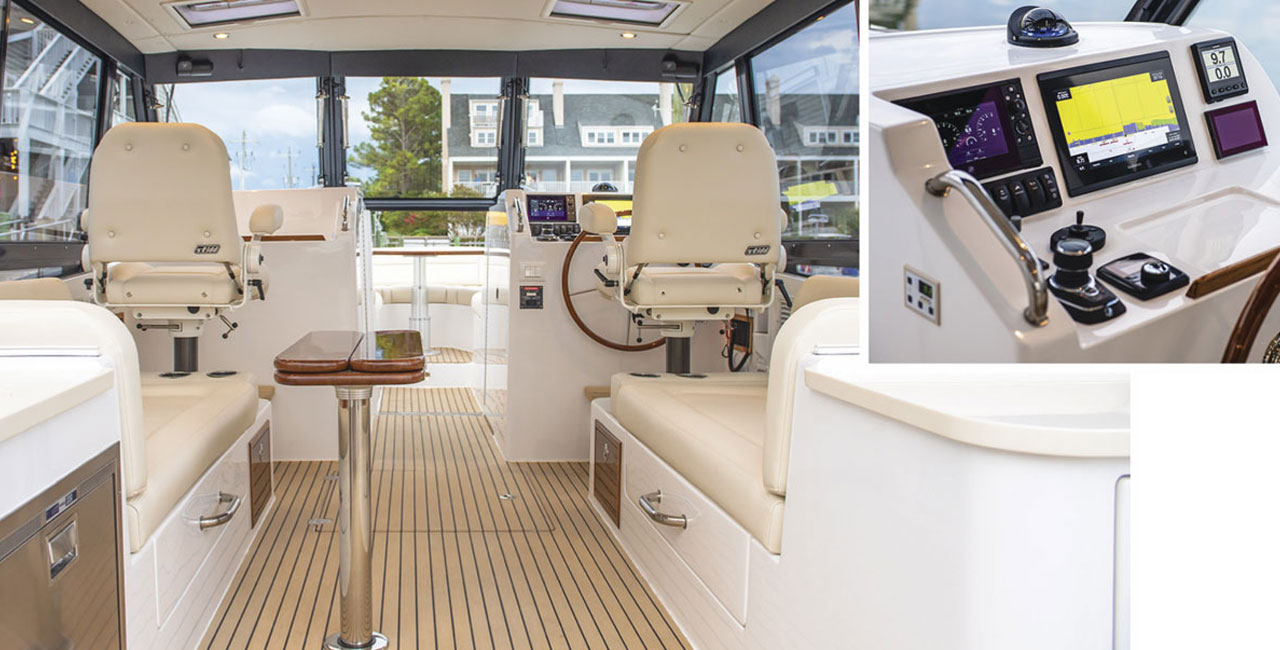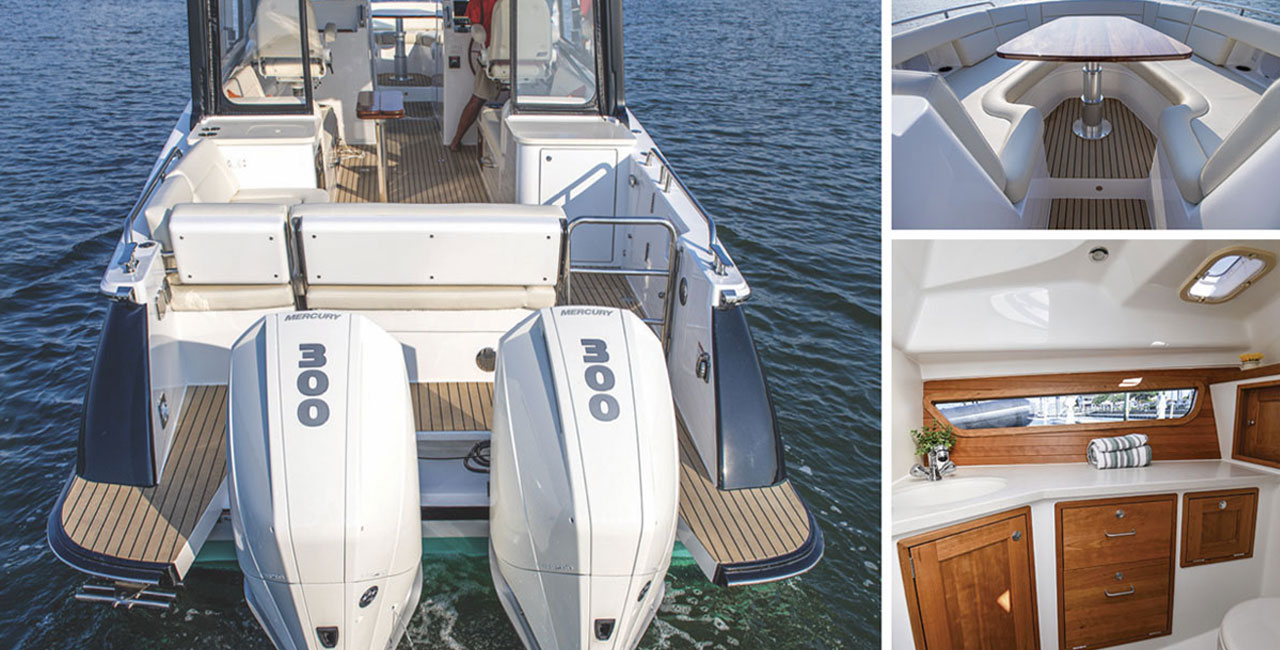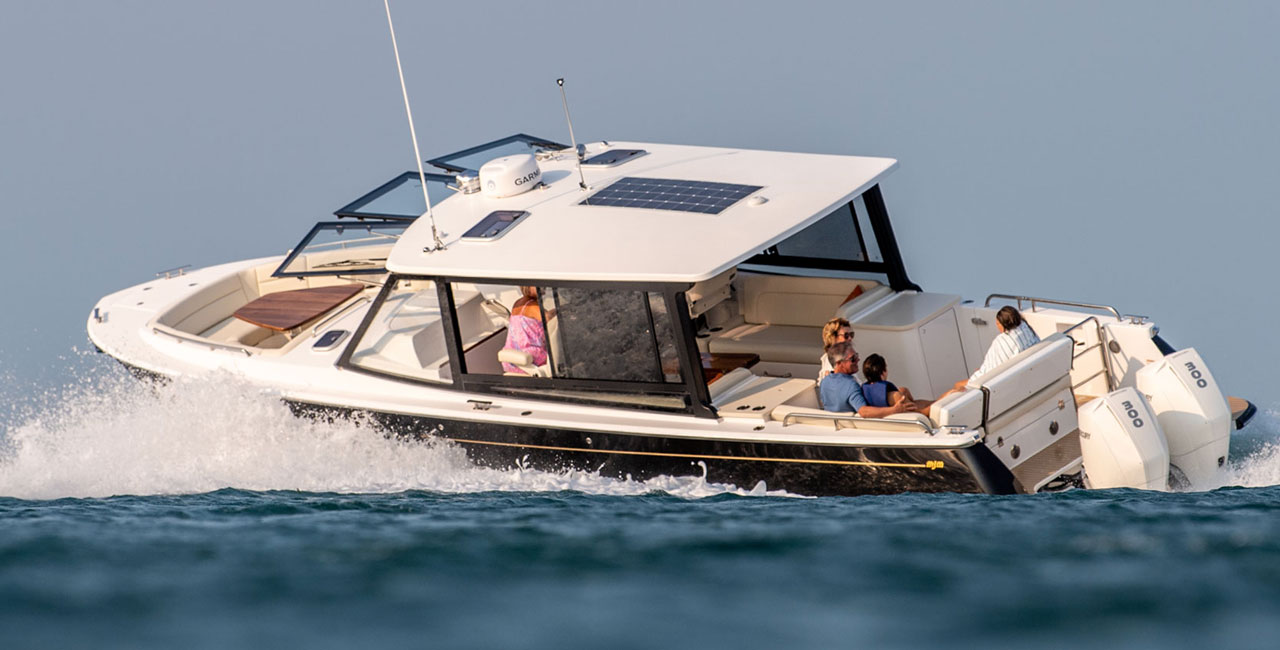By Steve Davis | Southern Boating
MJM HITS THE MARK WITH ITS NEW DAY YACHT THAT CAN CRUISE THE ICW AND TACKLE THE OCEAN
Boats are described with catchphrases From the Bottom Up all the time, but when MJM tagged its new MJM 3 day yacht “all-weather,” it meant it. A cloudy afternoon turned to rain on the Pamlico River along the shores of Washington, North Carolina, but the pilothouse on this luxury dual console kept the rain and wind at bay, even at 45 mph. The “Carolina Downeast-style” yacht is strong, stable, powerful, balanced, and best of all, fun to ride.
The 3 has that classic look, but the simple layout and clean design is a high-tech masterpiece. “Everything is well laid out,” says McKenzie Hutaff, MJM’s sales coordinator. “You have everything you need. It’s not too much. It’s nice and elegant, yet not over the top.” In other words, the boat checks all the boxes… rain or shine.
From the Bottom Up
The MJM 3 is built upon the popular 35z hull, one of Doug Zurn’s most advanced and efficient designs. It begins with the hull’s infusion process. “The infusion process is pretty special. We build the whole boat dry, so you have your outer skin of glass, foam core, your inner skin of glass, and it’s put under a vacuum bag. The vacuum bag is pressing down at one ton per square foot of pressure,” explains Peter Johnstone, MJM’s chairman. “So it really compacts the laminate, pulls out all the moisture, pulls out all the air, and when you know you have a good vacuum, then you do your infusion process. You open up the valves and let the resin get vacuumed in through the entire laminate. It gives the least amount of resin for a given laminate or process.”
In addition to the adhesive bond, this process provides a bond that results in a 25 percent gain in mechanical properties when compared to a hand-laid, vacuum-bagged, infusion process. MJM’s resin use averages in the mid to high 30 percent range, where typical processes for production boats (without vacuum bags) can range up to 70 percent. The result is a 30 percent weight savings in the deck and a 15 percent weight savings in the hull.
The reason so much weight is reduced in the deck is that all the molded components are also infused using the same process. “All the parts are infused, not just the hull,” says Johnstone. “We do our decks, which is probably the trickiest part, we do our grids, lids, everything.”

The Benefits of High-Tech Design
There are many advantages to decreasing the weight of a boat. For one, it uses a lot less fuel. Also, the 3 has twin 300-hp engines where most boats in the 38-foot size range use triples, thus 50 percent more fuel. Then there’s the speed efficiency. “The boat gets up on a plane around twelve to fourteen knots,” Johnstone says, which really helps when facing a steep chop. “If the Gulf Stream is, say, six- to eight-foot waves, and you need to drop down into the teens, MJM can ride level at twelve to fourteen just going through it. The full range of speed is available to you to pick what’s comfortable for the conditions.”
Speaking personally about riding level, I’ve never seen a boat “lift” its way onto plane like the 3. There’s no bow rise. From a dead stop to full throttle or a slow acceleration, the stern never dug a hole and the bow never stood up. The lighter hull and deck weights allow the boat to have a much narrower water plane, akin to a high performance, go-fast design and “not the typical heavy Downeast, sort of lobster boat,” adds Johnstone. “We start with a twenty-one-degree deadrise V and then up forward, it gets as sharp as fifty-five-degree deadrise, so you’ve got a really fine waterline forward that really goes through the waves. When you go to accelerate, the whole boat lifts rather than just the bow plowing water.” The narrower waterline and lighter displacement keep the boat up on the water and when accelerating, the whole platform goes up at the same time.

The Beauty of a Simple Layout
The technology behind boatbuilding is rarely seen when stepping aboard. The mechanical and electrical systems are installed on each section of the boat before the components are melded together. “The more boatbuilding you can do in sub assembly, the better off you are,” says Johnstone. “If you have to build the boat once it goes together, it takes four times as long.” It makes for a clean layout, and everything is accessible.
The same holds true on the deck. The one-level layout is simple with plenty of room to move from bow to stern. Three distinct social areas, the bow, the pilothouse, and the aft deck with swim platform, have their own personality, but when the three electric-powered windshield windows, the tinted, sliding glass windows on the side, and the aft roll-up StrataGlass panels are open, the entire boat becomes an entertainment center.
“The bow is really a sweet spot for me,” says Hutaff. She also loves the roominess of the pilothouse. “On the 35z, there’s a walkaround outside of the cabin to get to the bow, and you don’t need to do that on this boat, so the pilothouse becomes wider. The whole reason I fell in love with (this) MJM is because it’s one level, you’ve got your pilothouse that is climate- controlled, and you can go sit in the sun on the bow and have conversations with those at the helm, but what I love the most is that I can single-hand it.”
Lots of Amenities
The MJM 3 is a day yacht, but can easily sustain an overnight. There’s plenty of storage space and comfortable seating from stem to stern. Wraparound bow seating easily fits two people reclined on each side. A center table provides room for alfresco dining or snacks. Port and starboard settees inside the pilothouse seat six (or sleep two) with a folding table that opens to reach both sides. Helm and companion seats are fully adjustable and rotate 360 degrees, and the aft deck L-shaped seating configures into a daybed for napping or sunning.
On the aft deck, the starboard service station accommodates a sink with an icemaker or fridge below, while an electric grill is an option for the port-side station. Forward in the pilothouse, a full head and shower is hidden in the port console, yet easily accessible.
The helm is clean and efficient with all controls and Garmin displays mounted within arm’s length. Mercury’s digital fly-by-wire technology makes piloting easy and fun with joystick control, Skyhook digital anchor, auto trim with electric Zipwake trim tabs, Vessel View, and digital throttle. Switches, engine gauges, and bow thruster control are also conveniently within reach. A nicely designed inset in the dash is meant for an iPad, for one reason because MJM appreciates the Aqua Map app that’s only available on a smart device. The app connects with the Army Corps of Engineers’ soundings data in real time, so when navigation the inlets and ICW, you have the most up-to-date information…color coded. There are also 14 USB ports on board, and don’t worry about where to put your drink. There are 14 cupholders as well.
Numerous options add to your MJM 3 experience, including a Seakeeper, genset, bow thruster, air-conditioning, and more. As for that “all-weather” designation, the MJM 3 pilothouse provided an unobstructed 360-degree view and allowed us to enjoy a day on the water, even in the rain.
Specifications
LOA:
Beam:
Draft w/ Engines Up:
Draft w/ Engines Down:
Displacement:
Deadrise at Transome:
Fuel Capacity:
Water Capacity:
Standard Power:
Top Speed:
Cruise Speed:
38' 2'
11'
1' 9"
2' 8"
13,279 lb
16.8°
250 gal
58 gal
2 x Mercury Verado XL @ 300-hp (standard)
50 mph
35 mph

